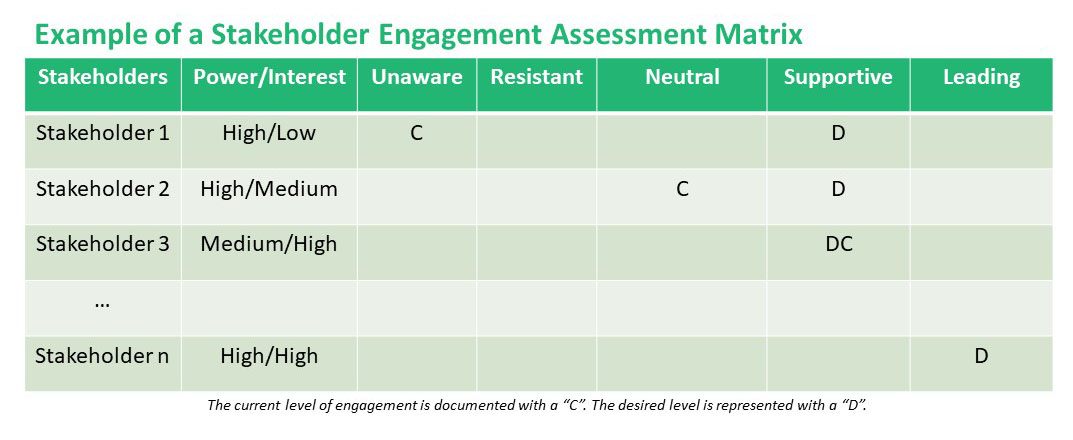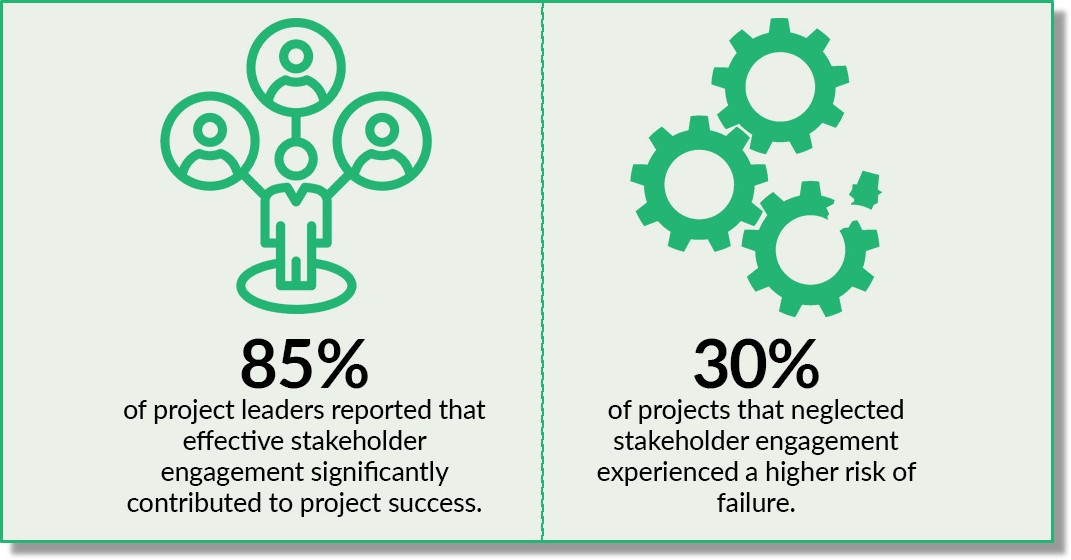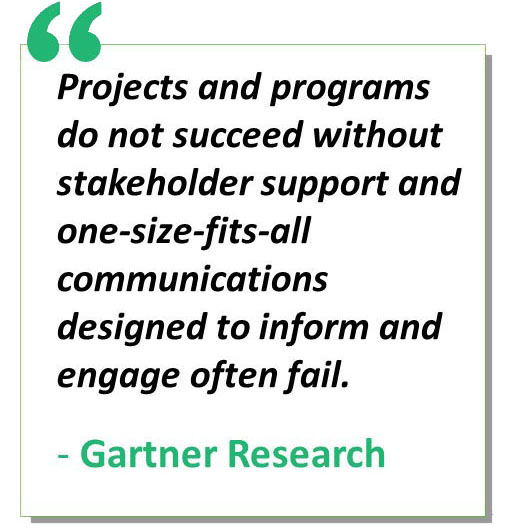
In project management, stakeholder engagement is a critical aspect that can make or break the success of a project. Therefore, project leaders must establish effective communication and engagement to ensure smooth collaboration and achieve project goals. One tool often utilized is the 'stakeholder engagement assessment matrix.' However, recent research and expert opinions shed light on its limitations and the need for a more robust approach. In this article, we will explore what a stakeholders engagement matrix is, common myths surrounding engagement levels of stakeholders, frequent mistakes in stakeholder engagement matrix, and how project leaders can create a strong stakeholder assessment matrix.
What Is a Stakeholder Engagement Assessment Matrix?
A stakeholder engagement assessment matrix is a visual representation that categorizes stakeholders based on their level of interest and influence in a project. It helps you (project managers or leaders) identify key stakeholders and understand their needs, expectations, and potential impact on the project. The matrix typically consists of a grid with multiple quadrants, each representing a different level of stakeholder engagement. Think of it as your navigation system, leading you to successful stakeholder engagement.
Categories of Stakeholders: Who Are They?
From a small software development project with a handful of stakeholders to a mega-infrastructure project involving numerous individuals and groups, stakeholders play a vital role in your project success. Stakeholders vary in their interest level, influence, and impact on a project. While it is impossible to create an exhaustive list of stakeholder categories due to project-specific considerations, let us explore some common categories:
- Primary stakeholders: They are individuals or groups directly affected by the project's outcome. They could be your clients, customers, or end-users, whose satisfaction and needs are of utmost importance.
- Secondary stakeholders: These stakeholders may have an indirect or moderate impact on the project but are not directly involved in its execution. Suppliers or regulatory bodies fall into this category.
- Tertiary stakeholders: These stakeholders have minimal impact or influence on the project but may have an interest in its outcome, such as the public or the media.

Are You Falling for These Common Stakeholder Engagement Myths?
Before diving into the stakeholder engagement assessment matrix, it is crucial to dispel some common myths associated with stakeholder engagement. In his blog, Mudassir Iqbal shares some misconceptions that swirl around stakeholder engagement:
- "Engaging all stakeholders is unnecessary": Identifying and engaging relevant stakeholders is crucial for project success. Neglecting key stakeholders can lead to conflicts, unexpected roadblocks, delays, and project failure.
- "Stakeholder engagement is a one-time activity": Successful stakeholder engagement requires ongoing communication and relationship-building throughout the project lifecycle. It is not a box to be checked, but an iterative process.
- "Stakeholder engagement is solely the project leader's responsibility": Engaging stakeholders is a collective effort that involves the entire project team. Everyone should understand the importance of stakeholder engagement and actively participate in fostering positive relationships.

Your Stakeholder Engagement Matrix Could Be Warning You!
“Projects and programs do not succeed without stakeholder support and one-size-fits-all communications designed to inform and engage often fail,” says Gartner Research. While stakeholder analysis is an essential component of the stakeholder engagement process, there are common mistakes you must avoid. What are some mistakes you could be committing? Let us find out:
- Incomplete stakeholder identification: Failing to identify all relevant stakeholders results in overlooking crucial perspectives and requirements. Thorough research and stakeholder mapping exercises are necessary to ensure inclusivity.
- Superficial stakeholder analysis: Merely listing stakeholders without considering their specific needs, interests, and influence leads to ineffective engagement strategies. Understanding stakeholders' motivations and power dynamics is critical to tailoring communication and involvement.
- Lack of stakeholder engagement planning: Without a clear plan for the engagement levels of stakeholders, you risk ad-hoc communication and inadequate involvement. A well-defined strategy ensures proactive engagement and mitigates potential issues.
Why Do Statistics Support the Need for Reliable Stakeholder Engagement?
 It is a systematic process that involves five key steps. To overcome the limitations of traditional stakeholder engagement matrices, you must adopt a more comprehensive approach. Here are some steps to create a robust engagement matrix:
It is a systematic process that involves five key steps. To overcome the limitations of traditional stakeholder engagement matrices, you must adopt a more comprehensive approach. Here are some steps to create a robust engagement matrix:
Identify and Prioritize Stakeholders
Conduct a thorough analysis of the engagement levels of stakeholders to identify relevant ones and categorize them based on their interest, influence, and potential impact on the project.
Understand Stakeholder Expectations and Needs
Engage in dialogue with stakeholders to understand their expectations, concerns, and requirements. Tailor your communication accordingly and address potential issues promptly.
Develop Tailored Engagement Strategies
Based on the stakeholder analysis, customize engagement strategies for each stakeholder group. This may include regular progress updates, consultation sessions, or involvement in decision-making processes.
Establish Open and Transparent Communication Channels
Provide stakeholders with multiple communication channels, such as meetings, emails, or online platforms, to voice their opinions and receive project updates. Remember, transparency fosters trust and increases stakeholder satisfaction.
Monitor and Evaluate Stakeholder Engagement
Continuously assess the effectiveness of engagement strategies and adjust them accordingly. Regular feedback loops and evaluation surveys provide insights into stakeholders' satisfaction levels and identify areas for improvement.
To further enhance your stakeholder engagement assessment matrix, leverage technology to prioritize project stakeholders' insights and feedback for project success. Modern project management tools and technology also offer project evaluation, which can further lead to internal growth, enhanced transparency, and a platform for stakeholders to raise concerns and issues. The insights are beneficial for you to facilitate seamless collaboration, communication, and stakeholder engagement throughout the project lifecycle.
It is here that TrueProject plays a critical role. TrueProject's expertise in stakeholder assessment lies in its ability to provide early issue identification, seamless data integration, comprehensive project governance, risk reduction, and enhanced decision-making. By consolidating project data, offering tailored solutions for different industries, and enabling proactive project management, TrueProject contributes significantly to the success of projects and the overall efficiency of organizations.
Stakeholder engagement is a vital component of project management, and the traditional stakeholder engagement assessment matrix has limitations. By understanding the categories of stakeholders, dispelling common myths, avoiding frequent analysis mistakes, and adopting a comprehensive approach, you can undoubtedly create a robust stakeholder engagement assessment matrix. So, start engaging stakeholders today with TrueProject and pave the way for a prosperous project journey.
 About the Author:
About the Author:
Dale Malcolm is the Director of TrueProject Customer Success with over 30 years of experience spanning software development, consulting, and business process re-engineering across multiple industries and countries. He has excelled in roles ranging from lead architect for data collection systems to database architect for telecom software and has led various teams in implementing cost-effective and efficient IT solutions, including ERP and Enterprise Architecture practices.
Endnotes:
- “How to build an effective stakeholders engagement assessment matrix.” monday.com, April 02, 2021. https://monday.com/blog/project-management/stakeholders-engagement-assessment-matrix/
- Iqbal, Mudassir. “Stakeholders Engagement Assessment Matrix.” Mudassir Iqbal, February 01, 2023. https://mudassiriqbal.net/stakeholders-engagement-assessment-matrix/
- “What are some common stakeholder analysis mistakes and how can you avoid them?” LinkedIn. https://www.linkedin.com/advice/0/what-some-common-stakeholder-analysis
- Cleverinsightsblog. “Best practices and common mistakes in stakeholder management.” Clever Insights, June 15, 2017. https://cleverinsightsblog.wordpress.com/2017/06/15/stakeholder-engagement/
- Burger, Rachel. “3 Mistakes All Project Managers Make With Their Stakeholders.” Capterra, June 22, 2015. https://www.capterra.com/resources/mistakes-all-project-managers-make-with-their-stakeholders/
- “Stakeholder Engagement Assessment Matrix: Uses & Example.” Project-Management.info. https://project-management.info/stakeholder-engagement-matrix/
- ARPA - Asia Regulatory Professionals Association. (n.d.). “Stakeholder management skill.” LinkedIn, January 21, 2023. https://www.linkedin.com/pulse/stakeholder-management-skill-arpaedu/
- “Develop a Stakeholder Analysis for Effective PMO Communications.” Gartner, 23 March 2020. https://www.gartner.com/en/documents/3982407





